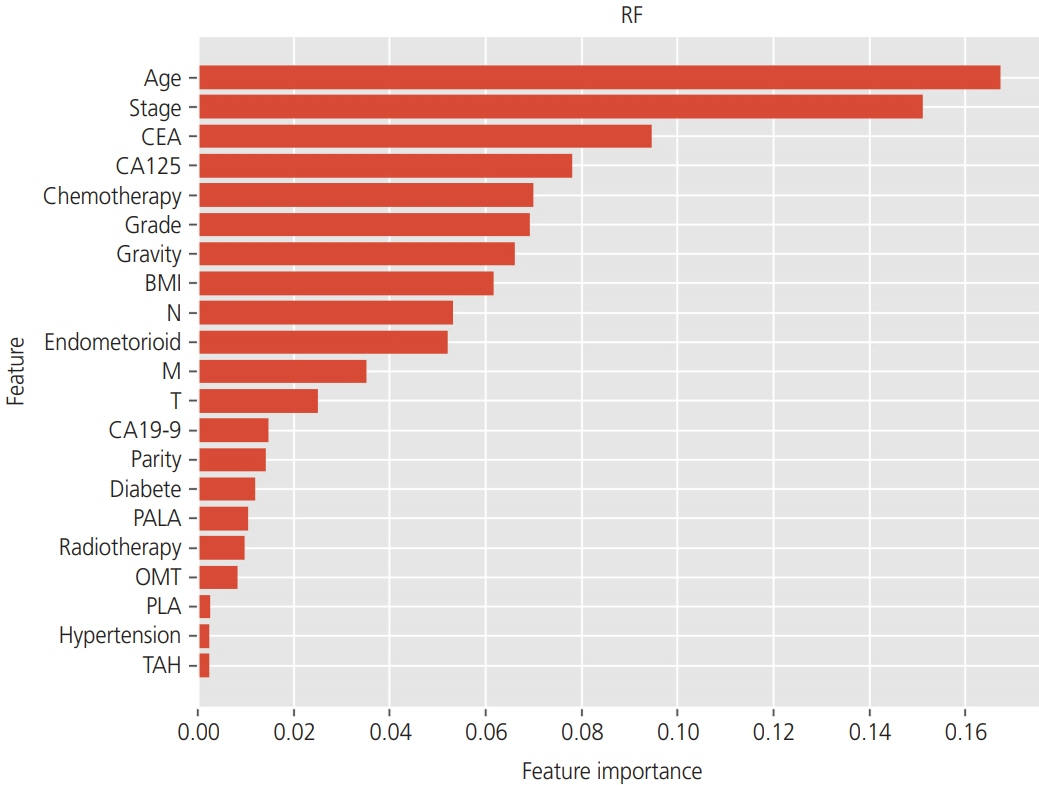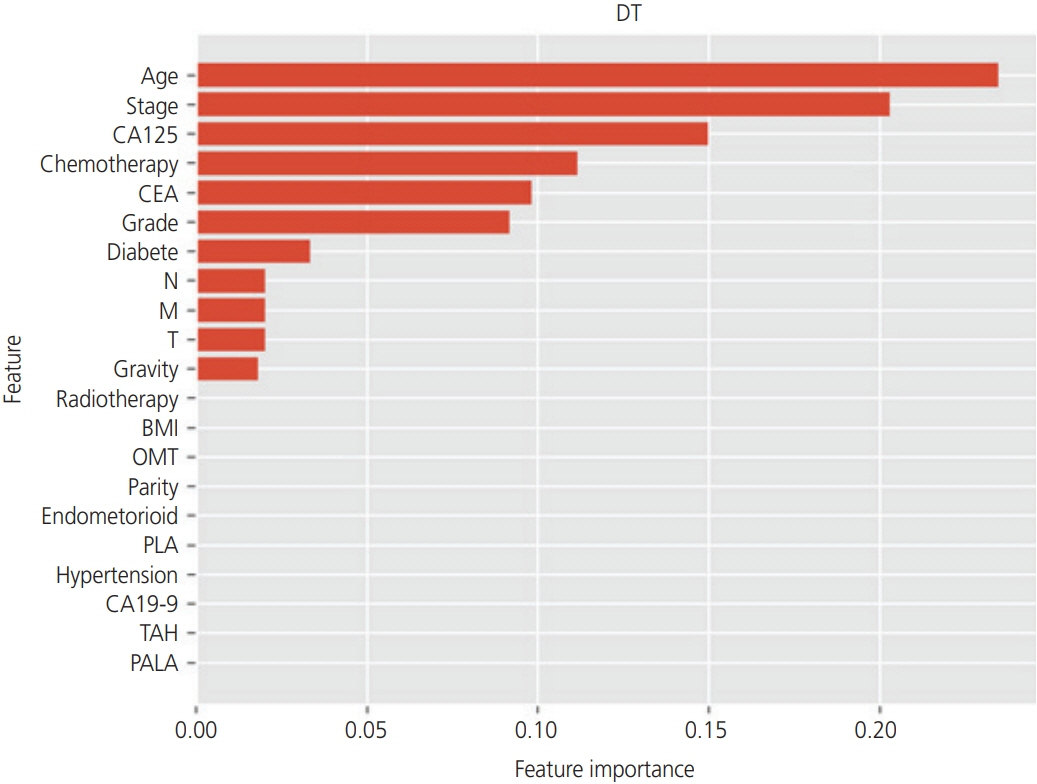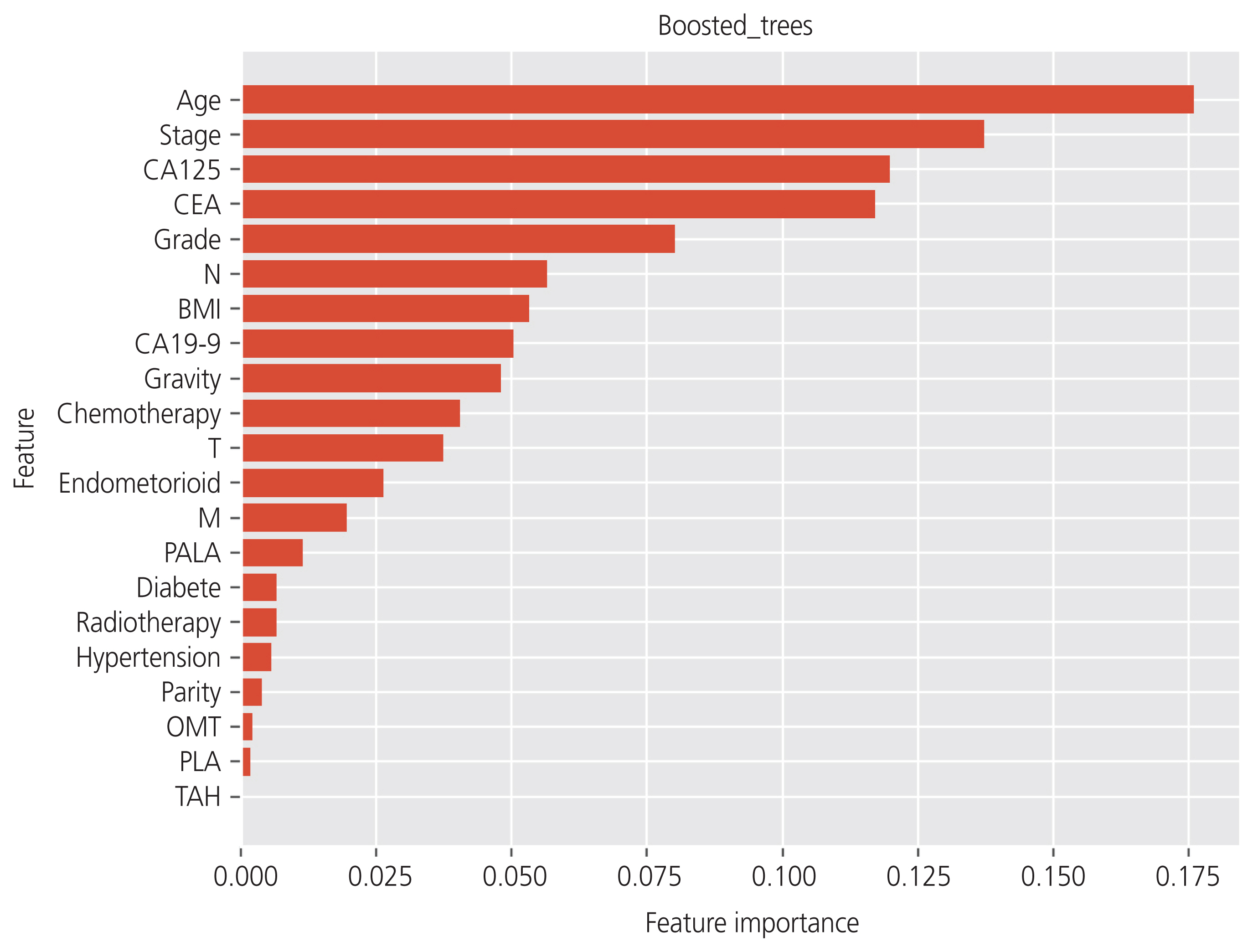Obstet Gynecol Sci.
2021 May;64(3):266-273. 10.5468/ogs.20248.
The application of machine learning for predicting recurrence in patients with early-stage endometrial cancer: a pilot study
- Affiliations
-
- 1Department of Obstetrics and Gynecology, Tokyo Women’s Medical University Medical Center East, Tokyo, Japan
- 2SIOS Technology Inc., Tokyo, Japan
- KMID: 2515978
- DOI: http://doi.org/10.5468/ogs.20248
Abstract
Objective
Most women with early stage endometrial cancer have a favorable prognosis. However, there is a subset of patients who develop recurrence. In addition to the pathological stage, clinical and therapeutic factors affect the probability of recurrence. Machine learning is a subtype of artificial intelligence that is considered effective for predictive tasks. We tried to predict recurrence in early stage endometrial cancer using machine learning methods based on clinical data.
Methods
We enrolled 75 patients with early stage endometrial cancer (International Federation of Gynecology and Obstetrics stage I or II) who had received surgical treatment at our institute. A total of 5 machine learning classifiers were used, including support vector machine (SVM), random forest (RF), decision tree (DT), logistic regression (LR), and boosted tree, to predict the recurrence based on 16 parameters (age, body mass index, gravity/parity, hypertension/diabetic, stage, histological type, grade, surgical content and adjuvant chemotherapy). We analyzed the classification accuracy and the area under the curve (AUC).
Results
The highest accuracy was 0.82 for SVM, followed by 0.77 for RF, 0.74 for LR, 0.66 for DT, and 0.66 for boosted trees. The highest AUC was 0.53 for LR, followed by 0.52 for boosted trees, 0.48 for DT, and 0.47 for RF. Therefore, the best predictive model for this analysis was LR.
Conclusion
The performance of the machine learning classifiers was not optimal owing to the small size of the dataset. The use of a machine learning model made it possible to predict recurrence in early stage endometrial cancer.
Figure
Cited by 1 articles
-
Artificial intelligence in obstetrics
Ki Hoon Ahn, Kwang-Sig Lee
Obstet Gynecol Sci. 2022;65(2):113-124. doi: 10.5468/ogs.21234.
Reference
-
References
1. Morice P, Leary A, Creutzberg C, Abu-Rustum N, Darai E. Endometrial cancer. Lancet. 2016; 387:1094–108.
Article2. Abu-Rustum NR, Zhou Q, Gomez JD, Alektiar KM, Hensley ML, Soslow RA, et al. A nomogram for predicting overall survival of women with endometrial cancer following primary therapy: toward improving individualized cancer care. Gynecol Oncol. 2010; 116:399–403.
Article3. Zhu L, Sun X, Bai W. Nomograms for predicting cancer-specific and overall survival among patients with endometrial carcinoma: a SEER based study. Front Oncol. 2020; 10:269.
Article4. Chilamkurthy S, Ghosh R, Tanamala S, Biviji M, Campeau NG, Venugopal VK, et al. Deep learning algorithms for detection of critical findings in head CT scans: a retrospective study. Lancet. 2018; 392:2388–96.
Article5. Esteva A, Kuprel B, Novoa RA, Ko J, Swetter SM, Blau HM, et al. Dermatologist-level classification of skin cancer with deep neural networks. Nature. 2017; 542:115–8.
Article6. Gulshan V, Peng L, Coram M, Stumpe MC, Wu D, Narayanaswamy A, et al. Development and validation of a deep learning algorithm for detection of diabetic retinopathy in retinal fundus photographs. JAMA. 2016; 316:2402–10.
Article7. Matsuo K, Purushotham S, Jiang B, Mandelbaum RS, Takiuchi T, Liu Y, et al. Survival outcome prediction in cervical cancer: Cox models vs deep-learning model. Am J Obstet Gynecol. 2019; 220:381.e1–14.
Article
- Full Text Links
- Actions
-
Cited
- CITED
-
- Close
- Share
- Similar articles
-
- Unlocking the future: Machine learning sheds light on prognostication for early-stage hepatocellular carcinoma: Editorial on “Conventional and machine learning-based risk scores for patients with early-stage hepatocellular carcinoma”
- Application of Machine Learning and Deep Learning in Imaging of Ischemic Stroke
- Treatment of Endometrial Cancer
- A Case of Recurrent Endometrial Carcinoma at the Vagina
- Adjuvant therapy for endometrial cancer





